Soc Trang takes on gateway mantle
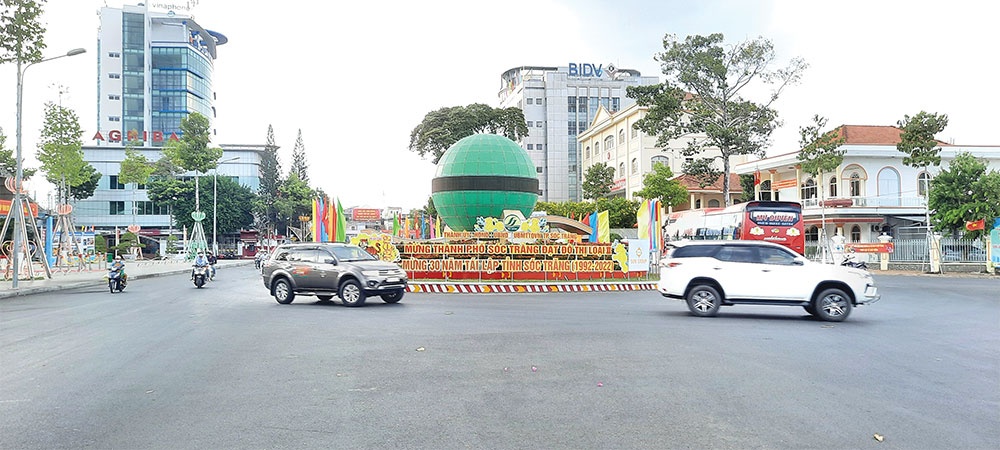 |
| From transport and agriculture to the marine economy, Soc Trang seeks a comprehensive overhaul |
The master plan for Soc Trang for this decade, with a vision to 2050, has been approved, meaning the Mekong Delta province can begin to take advantage of its strategic coastal location and inter-regional transport infrastructure.
By doing so, it is hoped Soc Trang can be transformed into the main gateway to the East Sea of the Mekong Delta and the regional hub for agriculture, industry, services, and logistics, with a focus on Tran De Seaport.
Soc Trang is already one of the more well-developed provinces of the Mekong Delta. It has developed manufacturing, commerce, services, and modern and sustainable agriculture. It developed Tran De Seaport with a comprehensive and modern infrastructure system, and boasts an urban system geared towards green, smart, and sustainable development with the ability to adapt to climate change.
By 2050, Soc Trang will become a developed area as a driving force for the Mekong Delta in association with the development of Tran De Seaport. The province operates a digital government, economy, and society for socioeconomic activities, as well as smart manufacturing and service industries under the digital economy, green economy, and circular economy models. Social areas are developed harmoniously while the environment and natural landscape are preserved.
Developing economic sectors
Soc Trang lies in the Mekong Delta lower section, close to the East Sea, with a total coastal line of 72km. Compared with other Mekong Delta provinces, Soc Trang also boasts advantages for general economic development, especially energy centres, seafood processing, logistic centres, and marine tourism.
Under the master plan, Soc Trang will promote economic restructuring in association with renewing the growth model on the basis of increasing productivity, applying scientific and technological advances, innovation, and digital transformation. Priority is given to the development of a number of industries and fields with ample potential and advantages in line with the new development space.
Specifically, the agricultural sector is developed in a green, sustainable, and modern direction to meet the requirements of both local and foreign markets. A specialised cultivation area will be formed to produce key commodities in line with the province’s strengths on an appropriate scale.
Science, technology, innovation, and digital transformation are actively applied in agricultural, forestry, and fishery production. It will also improve and develop plant, animal, and aquaculture varieties to adapt to climate change, soil conditions, and market demands.
In addition, Soc Trang is developing the value chains of key agricultural products in association with the processing industry and energy. The province continues to promote the development of One Commune, One Product items while building and positioning key agricultural product brands. More efforts will be made to develop diversified consumption markets, coupled with tourism. It will also launch programmes to support the development of sustainable agriculture with a focus on brackish water aquaculture, fruit trees, speciality rice, and cow raising.
Furthermore, Soc Trang will develop a green and highly competitive industry to create a breakthrough to improve productivity and rapidly increase the contribution of the processing and manufacturing industries with great added value.
Among them, the locality will develop the manufacturing and processing industry into a spearhead economic sector. This is coupled with diversifying industries, especially supporting industries. At the same time, the province will develop the clean energy sector and other industries associated with the marine economy.
For the services sector, a variety of areas will be developed quickly, especially high-quality services with high added value towards modernity, to meet the supply and demand of the market. Elsewhere, logistics is deemed the most important economic sector for the province. Logistics centres will be formed to receive and transhipment goods, as well as connect localities in the Mekong Delta with the entire country and beyond.
In terms of commercial infrastructure, the province places a priority on commercial infrastructure, which has a strong spillover effect on trade flow. Focus is also given to developing logistics infrastructure, especially transportation, warehouses, and the application of new technology in logistics, with priority investment at Tran De Seaport.
At the same time, tourism is also developing into an important economic sector with key and supplementary related products. Based on the potential and advantages of the province, different areas will be promoted, such as cultural and culinary tourism, festivals, and park and marine ecotourism, as well as resorts with sports and entertainment. It will also link its tourism products with those of other localities in the region.
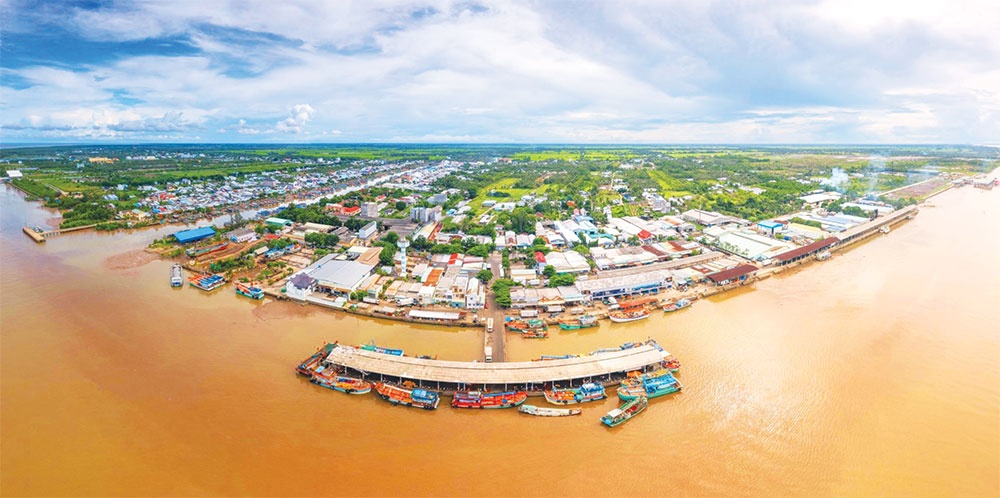 |
| By 2050, Soc Trang will become a developed area in Mekong Delta region with the development of Tran De Seaport |
Crafting new corridors
To unlock the potential of the marine economy and create new economic driving forces, the master plan outlines a development orientation for Soc Trang based on two economic corridors and four socioeconomic areas.
The two economic corridors include the north-south and east-west corridors. The former features National Highway No.1 connecting Ho Chi Minh City, Can Tho, Soc Trang, and Ca Mau to accommodate interprovincial goods volume.
The Can Tho-Soc Trang-Ca Mau and Can Tho-Soc Trang routes are responsible for collecting raw materials for the processing industry and expanding the regional gateway for Tran De Seaport. The Soc Trang-Bac Lieu route connects Soc Trang with Bac Lieu through the coastal road.
National Highway No.60 connects Nga Nam town, Thanh Tri district, My Tu district, Chau Thanh district, Soc Trang city, Long Phu district, and Tra Vinh province.
Meanwhile, the east-west economic corridor includes Chau Doc-Can Tho-Soc Trang Expressway, connecting Tran De Seaport with the western regions of the Mekong Delta and Cambodia.
Provincial Road No.937B connects Nga Nam town, Thanh Tri district, My Xuyen district, and Vinh Chau town; while Provincial Road No.934B is one of the driving forces for the development of the province, connecting Soc Trang city and Tran De district.
The four socioeconomic areas include the coastal zone, the Hau riverside region, the inland region, and the Cu Lao Dung region.
The coastal area covers the entire land area of Soc Trang city with the mainland and the marine part of Vinh Chau town and Tran De district. This area is the driving force and the centre of development for the province.
The coastal economy will be developed here across sectors and fields including urban, industry, commerce, logistics services, tourism, agriculture, the marine economy, and seaports.
The Hau riverside region covers the entire area of Chau Thanh, Ke Sach, and Long Phu districts. The economy along the Hau River will be developed with a focus on highly efficient agriculture, industry, urban areas, and services.
The inland region covers the entire area of Nga Nam town, Thanh Tri district, My Tu district, and My Xuyen district. To develop the inland economy, the province will take advantage of stronger conditions to promote agricultural production associated with industry, urban areas, and services.
Finally, the Cu Lao Dung area, which consists only of Cu Lao Dung district, is oriented towards the development of tourism in line with urban, commercial, service, and agricultural models. This is a key tourist area for Soc Trang, with a vision to become a high-class resort and a place worth living for people from both inside and outside the province.
By 2030, Soc Trang will also research and develop the Tran De coastal economic zone along the Tran De estuary and the coastal area. With an estimated scale of 40,000 hectares, it will be a general economic zone and multi-functional to synchronously exploit Tran De Seaport.
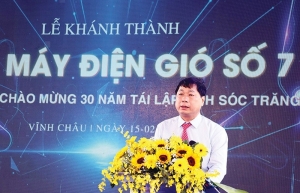 | Soc Trang to accompany all investors The Mekong Delta province of Soc Trang will be hosting a major investment promotion conference on April 28. To mark the occasion, Lam Hoang Nghiep, Deputy Chairman of Soc Trang People’s Committee, talked with VIR’s Huu Phuc about the local potential in its strategy for investment attraction and development. |
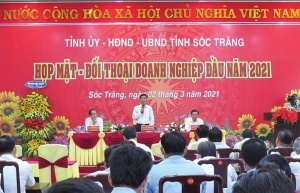 | Soc Trang province looks to prosper by leaps and bounds A raft of forthcoming infrastructure projects will lay concerted groundwork for Soc Trang province to break through and become one of the most vibrant commercial and industrial hubs in the Mekong Delta region. |
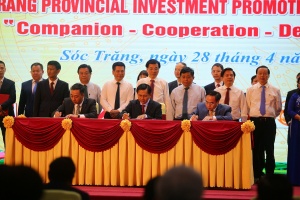 | Soc Trang lures over $8.7 billion in committed investment capital Soc Trang has recently granted investment certificates for four projects and signed 18 MoUs on investment study and surveys with the total registered capital of more than $8.7 billion. |
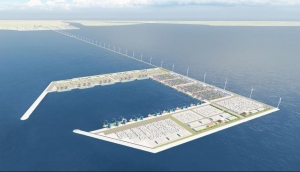 | Soc Trang seeks feasibility report on Tran De Seaport Soc Trang People’s Committee is proposing developing Tran De Seaport under a Public-Private Partnership (PPP) and, to promote the venture as an investment opportunity, is seeking the Ministry of Transport’s approval to use local budgetary funds to draft a feasibility report for its construction. |
What the stars mean:
★ Poor ★ ★ Promising ★★★ Good ★★★★ Very good ★★★★★ Exceptional
Related Contents
Latest News
More News
- KK Group opens global flagship store in Ho Chi Minh City (January 19, 2026 | 11:52)
- Gia Lai draws over $1bn in new investment so far this year (January 19, 2026 | 11:50)
- Unlocking capital flows for strategic and suitable projects (January 18, 2026 | 09:00)
- ACV begins cargo terminal construction at Danang Airport (January 17, 2026 | 15:57)
- Viettel starts construction of semiconductor chip production plant (January 16, 2026 | 21:30)
- Bel expands Vietnam production with $19.7 million investment (January 16, 2026 | 16:07)
- ASML signals long-term commitment to Vietnam (January 16, 2026 | 12:00)
- Ho Chi Minh City starts construction of four key infrastructure projects (January 15, 2026 | 17:22)
- PIDG invests with AquaOne to expand Xuan Mai’s treated water supply to Hanoi (January 15, 2026 | 11:16)
- Vietnam ranks 38th in global AI adoption (January 14, 2026 | 16:01)

 Tag:
Tag:




















 Mobile Version
Mobile Version